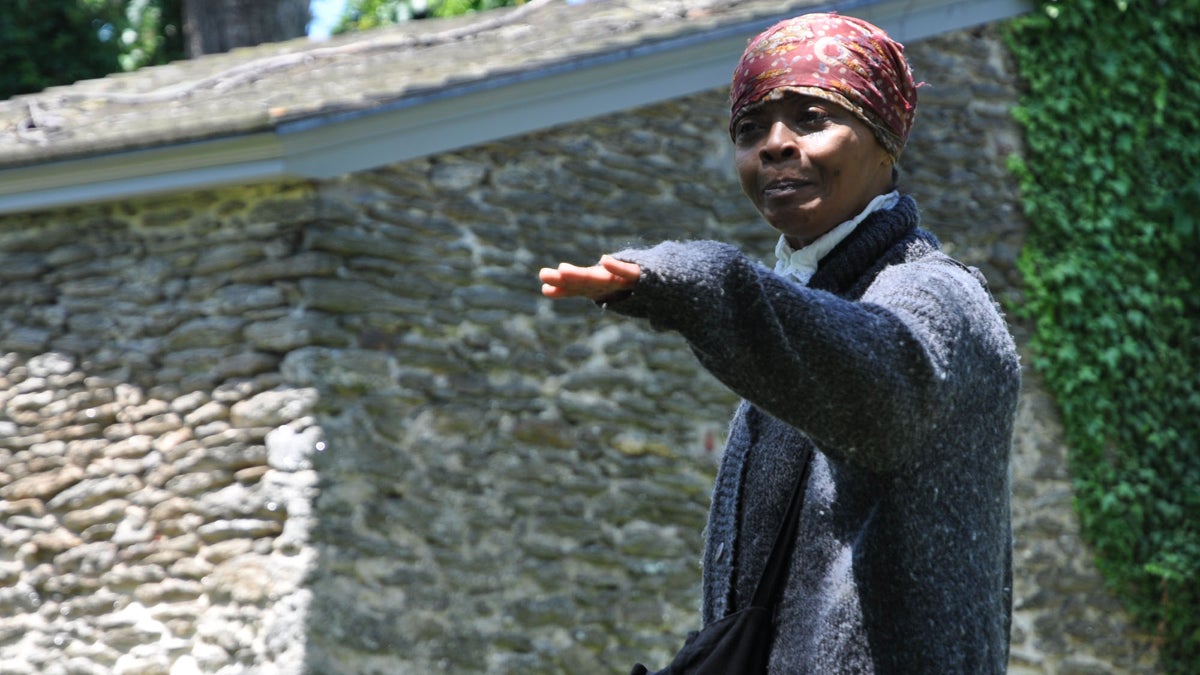Harriet Tubman’s story was less lonesome than history makes it seem
Listen
Actress Millicent Sparks performs a monologue as Harriet Tubman at the Johnson House historic site in Germantown for the 2011 Juneteenth National Freedom Day Festival. (Yara Simón for NewsWorks
What is it about Harriet Tubman?
A 2008 survey of adult Americans listed her as the ninth most famous American, excluding presidents and first ladies. High school students ranked her third, after Martin Luther King, Jr. and Rosa Parks.
And Tubman—not Parks, or Susan B. Anthony—will replace Andrew Jackson on the front of the $20 bill, as Treasury Secretary Jack Lew announced on Wednesday. “It is the essential story of American democracy about how one person . . . could change the course of history,” Lew declared, explaining how his department chose Tubman over other candidates amid a groundswell of popular demand for women on our currency.
Actually, Tubman’s story shows the opposite of what Lew said. It’s about about how one person joined with an extensive network of fellow activists to publicize the evils of slavery and shepherd a few people to freedom. But we persist in seeing her as a lone warrior, fighting the good fight all by herself.
By the time Harriet Tubman escaped from a Maryland plantation in 1849 to Philadelphia, where she worked as a cook, African-Americans and their white allies had been assisting fugitives from slavery for more than 50 years. They provided food, shelter, clothing, and medical care to escaped slaves; they also helped fugitives find jobs in the North.
With the advent of train travel in the 1830s and 1840s, this antislavery network took on a new name: The Underground Railroad. Operatives become known as conductors or stationmasters, while escaped people were called packages.But Harriet Tubman didn’t “start” or “found” the Underground Railroad, as many people still believe. Nor did she personally lead “thousands” of slaves out of bondage, as some popular accounts have claimed. Historians estimate that she personally brought 60 to 80 people to freedom during her dozen brave trips back into the American South.
She also worked closely with other leading antislavery figures of her time, including Frederick Douglass and William Lloyd Garrison. Like Douglass, she raised money for the cause by giving personal testimonials about her experiences in bondage and her escape from it. When abolitionist firebrand John Brown was arrested in his aborted 1859 raid at Harper’s Ferry, Harriet Tubman was on her way to join him.
So why do we remember Tubman as a solitary figure in the wilderness, leading her people into the promised land? Starting in the Great Depression of the 1930s, left-leaning Americans transformed Tubman into a precursor of their own campaigns for labor unions, public relief, and other causes. “I swore I’d give my life blood/ Just to turn my people free,” folksinger Guthrie sang in his “Ballad of Harriet Tubman,” which was also recorded by Pete Seeger.
And during the civil rights era, Tubman inspired a new generation of activists who fought segregation and white supremacy. She was also embraced by the burgeoning feminist movement, who saw her as a model of strong womanhood.These themes were especially dominant in books aimed at young adults and children. More than 40 juvenile biographies of Tubman hit the shelves in the civil rights years, bearing titles like Journey to Freedom and Wanted, Dead or Alive. And most of them made Tubman into a lone heroine, who harnessed her own courage and cleverness to lead blacks out of slavery.
But that strategy actually diminished campaigns for social justice, all in the guise of celebrating them. The more we lionized figures like Harriet Tubman—or, later, civil rights leaders such as King or Parks—the less we thought about the millions of unsung organizers and protesters who also fought for freedom.
Indeed, the focus on singular individuals makes us forget as much as we remember. Two decades ago, the former basketball star Kareem Abdul-Jabbar wrote about a friend who was teaching at an elementary school outside of Atlanta. “Her kids know so little about black history that they answer Harriet Tubman for everything,” Jabbar worried.
Let’s be clear: Harriet Tubman is a genuine American heroine. So are Susan B. Anthony—who will appear on the back of the new $10 bill—and black opera singer Marian Anderson, who will join Eleanor Roosevelt on the back of the $5. But all of these women were part of social movements much bigger than themselves. For my money, that’s the most important history lesson of all.
WHYY is your source for fact-based, in-depth journalism and information. As a nonprofit organization, we rely on financial support from readers like you. Please give today.




